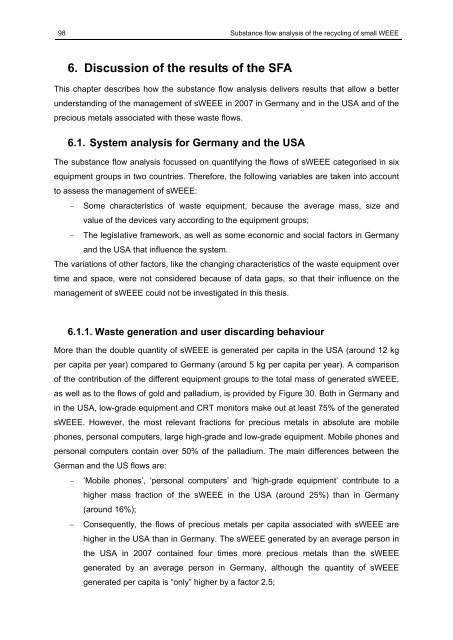SUbstance flow analysis of the recycling of small waste electrical ...
SUbstance flow analysis of the recycling of small waste electrical ...
SUbstance flow analysis of the recycling of small waste electrical ...
Create successful ePaper yourself
Turn your PDF publications into a flip-book with our unique Google optimized e-Paper software.
98 Substance <strong>flow</strong> <strong>analysis</strong> <strong>of</strong> <strong>the</strong> <strong>recycling</strong> <strong>of</strong> <strong>small</strong> WEEE<br />
6. Discussion <strong>of</strong> <strong>the</strong> results <strong>of</strong> <strong>the</strong> SFA<br />
This chapter describes how <strong>the</strong> substance <strong>flow</strong> <strong>analysis</strong> delivers results that allow a better<br />
understanding <strong>of</strong> <strong>the</strong> management <strong>of</strong> sWEEE in 2007 in Germany and in <strong>the</strong> USA and <strong>of</strong> <strong>the</strong><br />
precious metals associated with <strong>the</strong>se <strong>waste</strong> <strong>flow</strong>s.<br />
6.1. System <strong>analysis</strong> for Germany and <strong>the</strong> USA<br />
The substance <strong>flow</strong> <strong>analysis</strong> focussed on quantifying <strong>the</strong> <strong>flow</strong>s <strong>of</strong> sWEEE categorised in six<br />
equipment groups in two countries. Therefore, <strong>the</strong> following variables are taken into account<br />
to assess <strong>the</strong> management <strong>of</strong> sWEEE:<br />
Some characteristics <strong>of</strong> <strong>waste</strong> equipment, because <strong>the</strong> average mass, size and<br />
value <strong>of</strong> <strong>the</strong> devices vary according to <strong>the</strong> equipment groups;<br />
The legislative framework, as well as some economic and social factors in Germany<br />
and <strong>the</strong> USA that influence <strong>the</strong> system.<br />
The variations <strong>of</strong> o<strong>the</strong>r factors, like <strong>the</strong> changing characteristics <strong>of</strong> <strong>the</strong> <strong>waste</strong> equipment over<br />
time and space, were not considered because <strong>of</strong> data gaps, so that <strong>the</strong>ir influence on <strong>the</strong><br />
management <strong>of</strong> sWEEE could not be investigated in this <strong>the</strong>sis.<br />
6.1.1. Waste generation and user discarding behaviour<br />
More than <strong>the</strong> double quantity <strong>of</strong> sWEEE is generated per capita in <strong>the</strong> USA (around 12 kg<br />
per capita per year) compared to Germany (around 5 kg per capita per year). A comparison<br />
<strong>of</strong> <strong>the</strong> contribution <strong>of</strong> <strong>the</strong> different equipment groups to <strong>the</strong> total mass <strong>of</strong> generated sWEEE,<br />
as well as to <strong>the</strong> <strong>flow</strong>s <strong>of</strong> gold and palladium, is provided by Figure 30. Both in Germany and<br />
in <strong>the</strong> USA, low-grade equipment and CRT monitors make out at least 75% <strong>of</strong> <strong>the</strong> generated<br />
sWEEE. However, <strong>the</strong> most relevant fractions for precious metals in absolute are mobile<br />
phones, personal computers, large high-grade and low-grade equipment. Mobile phones and<br />
personal computers contain over 50% <strong>of</strong> <strong>the</strong> palladium. The main differences between <strong>the</strong><br />
German and <strong>the</strong> US <strong>flow</strong>s are:<br />
‘Mobile phones’, ‘personal computers’ and ‘high-grade equipment’ contribute to a<br />
higher mass fraction <strong>of</strong> <strong>the</strong> sWEEE in <strong>the</strong> USA (around 25%) than in Germany<br />
(around 16%);<br />
Consequently, <strong>the</strong> <strong>flow</strong>s <strong>of</strong> precious metals per capita associated with sWEEE are<br />
higher in <strong>the</strong> USA than in Germany. The sWEEE generated by an average person in<br />
<strong>the</strong> USA in 2007 contained four times more precious metals than <strong>the</strong> sWEEE<br />
generated by an average person in Germany, although <strong>the</strong> quantity <strong>of</strong> sWEEE<br />
generated per capita is “only” higher by a factor 2.5;

















